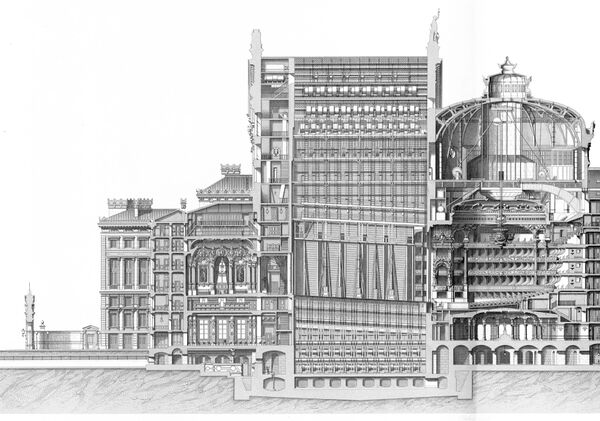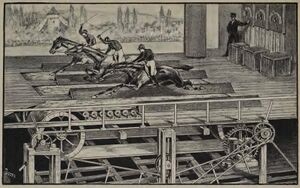The Steel Stage
The advent of cheap and easily available steel in the second half of the 19th century transformed the construction of theatre buildings, stages and machinery.
Steel has been known as a material since antiquity, but until the 19th century its production was expensive. In 1855 Henry Bessemer introduced a new process that could make steel much more cheaply and in large quantities. This innovation had a substantial effect on theatre buildings and the technology used in them: steel, held together with rivets, could build wider spans and stronger constructions in less space. The Opéra Garnier (Q365), designed in 1861 by Charles Garnier and opened in 1875, has a steel frame for the structure of the building that make it possible to have slender pillars, creating more interior space.
Before the ready availability of steel, the upper levels in theatre auditoriums – the balconies and boxes – were supported by structures made of wood, wrought iron or cast iron. These materials don’t have the strength for large, unsupported spans, so balconies had to be shallow, just a few rows of seats deep, and with many pillars at the front obstructing the view. Steel construction allowed deeply-shelved levels, without pillars. Cheap steel coincided with and enabled a change in auditorium design, away from the horseshoe shape, where spectators in the balconies could look at each other as much as they could see the stage, towards more rectangular spaces, without seats on the side walls, where everyone faced forwards, towards the stage. Theatre became less about a shared, communal experience in which an audience watches the stage action together, and more about an individual, immersive experience of the fictional world of the drama (D.05).
The introduction of steel also impacted the construction of the stage and its machinery. Before the Industrial Age the upper machinery was mostly build as a hemp system (named after the type of rope used, Q678), manually powered by wooden shafts and drums, and supported by free hanging counterweights. The battens were placed temporarily where needed, which gave good flexibility. Steel construction made it possible to develop counterweight systems (Q15920) where the weights were guided and balanced. The fly bars were hung permanently and parallel to each other at pre-defined distances. These systems were less flexible, but improved the working conditions and the efficiency greatly, as well as allowing much larger and heavier scenery.
On stage, wagons (also known as trucks, Q4298) could be used, guided by rails in the floor; the steel construction meant their height could be kept low, minimising the visual impact. New, spectacular effects were developed. The revolving stage (Q3536) was already used in Japanese theatre in the latter half of the Edo Period in Kabuki theatre where they were called mawaributai (Q30618), and in 1617 at the Palais du Louvre a first experiment with a turntable (Q30619) took place. Karl Lautenschläger (Q418) developed the revolve further at the Residenztheater (Q13019) in Munich 1896. In 1954 a ‘drum revolve’ (Q30620) with built in elevators was developed by Sepp Nordegg, and a similar concept was installed in the 1970s in the Olivier space at London’s National Theatre (Q9343) – all these later developments were only possible with steel construction.
The first steel under-stages were built as a steel copy of the earlier wooden type, but with the use of steel, the chariots (Q19399) for moving the scenery could be much smaller, creating space for other uses. Larger elevators could be integrated, powered by hydraulic and later electrical motors (A.05). In a second phase, the chariots disappeared, giving more freedom to organise the under stage.
Steel was not only used in permanent machinery. For the staging of Ben Hur, a device was developed for the race (Q30617) consisting of two movable treadmills for the chariots and the live horses. The background was created by a moving panorama (Q23451). Other ideas from this innovative period didn’t catch on. The Grand-Théâtre de Lyon, for example, had a unique revolving double stage (Q512): the rotating under-stage was a traditional chariot stage, and the grid also turned, suspended from a massive central pivot. Hanging scenery and lights turned with the standing sets.
Another idea that didn’t make it was the elevator stage. The first elevator stage was built for the Madison Square Theatre in New York (Q30616) designed by Steele MacKaye. The construction consisted of two stages, each with a grid, that were built on top of each other and that could move up and down as a whole, so that either one stage or the other could be seen through the proscenium opening, making quick changeovers possible between the two scenes.
The introduction of steel in theatre machinery marks the turning point between manually operated wooden equipment and motorised steel equipment, and was the start for further development and changing working methods. The timing of these changes, however, depends on the type and size of theatre, the type of productions and on regional differences. Germany was an early adaptor, but in other countries the change was only seen in major opera houses or large city theatres. In some countries like the UK and Italy the tradition of ‘hemp houses’ still exists in smaller venues.

